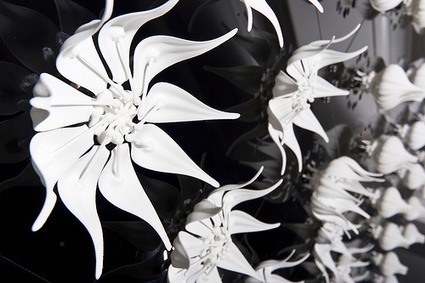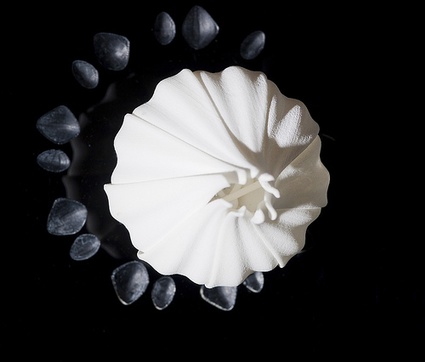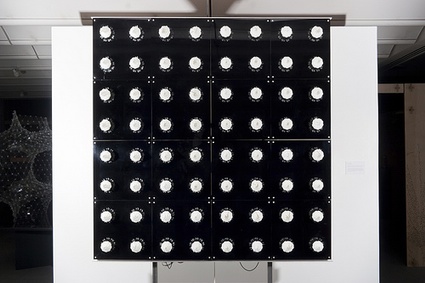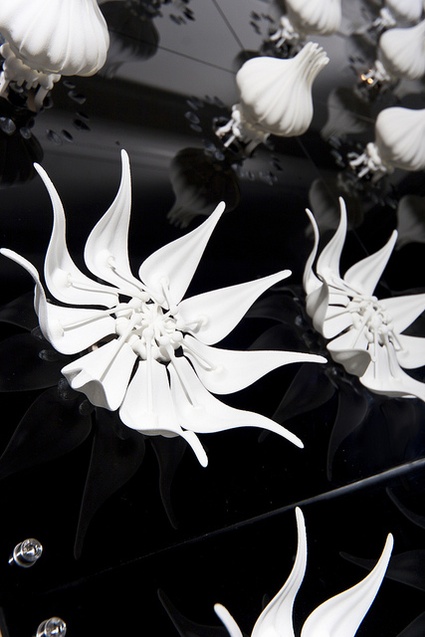One last project i discovered at Constructing Realities, an exhibition that showcases the best work from the Postgraduate Certificate Course in Advanced Architectural Research, at the Bartlett School of Architecture, UCL in London.
 Photo by Gavin Bambrick
Photo by Gavin Bambrick
Adaptive Bloom, by Justin Goodyer, is a responsive screen speculatively proposed as a stage set for a dance performance in which the screen is the third partner in the choreography, it responds to the dancers and vice-versa. The screen consists of a pixel grid of blooming, mechanical flowers developed through the manufacture of a series of laser sintered prototypes.
Justin Goodyer: Adaptive Bloom – Bartlett School of Architecture from Ruairi Glynn on Vimeo.
The prototype shown in the Constructing Realities exhibition is purely reactive. It gets “bored” if no one has interacted with it for a while, from 10-60 seconds, and performs a random display to entice people and then each flower is triggered if you move in front of it.
The text below describes the role of the screen in a dance performance:
The performance is framed by the lyrics to the song Busby Berkeley Dreams. A heartbroken woman abandoned by her lover dreams of him come back to her each night. In her fantasies, they dance together in kaleidoscopic rhapsodies.
The dance features three performers: one male, one female and the responsive screen. Using ideas taken from William Forsythe‘s work on structured improvisation, each dancer will be given a series of movements, a series of transformations applied to the movements and a series of environmental triggers to activate them.
 Photo by Gavin Bambrick
Photo by Gavin Bambrick
For example, upon perceiving a left to right movement passing behind him in the screen the male dancer would take the last movement made by the female and mirror it diagonally across his body. Similarly, the screen plays back recorded movements and applies its own transformations.
The system does not create a single performance but a space of possible dances for the artists to explore.
The female is to be dressed in bright red clothing, the male in black and the screen made of white flowers against a black backing. The female will always be clearly visible but the male will appear as a silhouette only when he stands in front of the flowers in an open (more white) state, making his presence transient and ethereal. The goal of the female is to activate the entire grid, turning the backdrop completely white and revealing the male. Conversely the goal of the male is to lower the activity of the screen and disappear into its black background. The resulting performance therefore becomes an unpredictable, oneiric spectacle of undetermined length as the two performers compete to fulfill their goals.
The score will have an aleatoric structure, composed as a series of blocks and triggered by the activation level of the screen. At each successive increment of activation a new block will start playing resulting in cascades and crescendos of sound growing in intensity as the female gets closer to her goal.
 Photo by Gavin Bambrick
Photo by Gavin Bambrick
Hi, Justin! Why did you decide to work with the dance environment? Do you have a background in dance or choreography?
Justin: I don’t have a background in dance or choreography. I decided to work in the medium because it is possible to make ideas of process and genesis that I have been developing over the last few years visible, albeit in a very abstract and simplistic form. I believe there are two ways to approach the problem of design. The first could be called “The Classical” in which one would take an externally generated concept and apply it to their material – a proportioning system would be a very clear architectural example. The second could be called “The Gothic” in which one seeks to explore, understand and express the qualities of the material they are working with. The vaulting and flying buttresses of a gothic cathedral would be an architectural example.
I subscribe to the second but favour exploration over optimisation and actually consider my method to be closer to surrealist automatism than engineering. Typically I construct a space of possibilities based on the constraints of my materials and an exploratory apparatus to navigate it. Together they produce a space of manifestations, a number of designs or in this case a number of bodily movements. This is achieved through algorithmic processes and is the main application of technology and computing in my work. The dance is thus a revelation and celebration of these ideas as well as, hopefully, a very beautiful and poetic spectacle in its own right.
 Photo by Gavin Bambrick
Photo by Gavin Bambrick
Have you already started working with a dance company or choreographer?
Justin: I would love to work with a choreographer and dance group but have not lined anything up. I plan to look into the interaction and coding a little more and then see if I can get a dance school involved. I guess I will work with projections though.
Thanks Justin!
The prototypes, models and sketches on show at Constructing Realities were as innovative as they were different from each other, see for example two other works i discovered there: Subverting the LiDAR Landscape: Tactics of spatial redefinition and The Fortress of Senses – Rescripting Landscapes.) The exhibition runs until October, 1st at PHASE 2 Gallery, 8 Fitzroy St, London W1T 4BJ (map.)
Related: Book Review: Digital Architecture – Passages Through Hinterlands.
